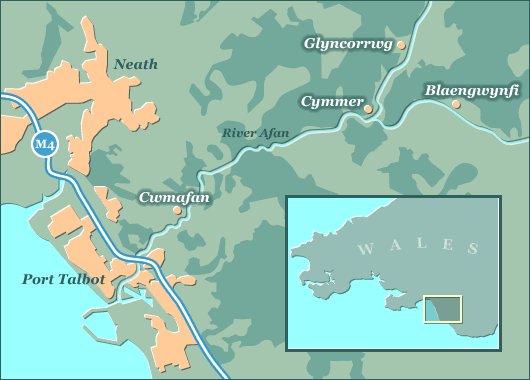
The Afan valley is situated in South Wales, the River Afan being one of many that drain the uplands of the South Wales coalfield. At its mouth is the industrial town of Port Talbot. To the west lies Swansea and some thirty miles to the east is Cardiff, Wales’ capital city.

Water action aided by the melting of large ice sheets at the end of the Ice Age created a narrow, winding steep sided valley. The river has its source in the mountains above Blaengwnfi and flows for some twelve miles, along its course being joined by tributaries such as the Corrwg and Pelenna until it enters the Bristol Channel at Port Talbot.
The upper valley villages above Pontrhydyfen developed as centres of coal mining. In the lower valley centred on Cwmafan the iron and tinplate industries and the smelting of copper were also important.
Two hundred years ago the valley was largely rural. On the fertile lands on the floor of the lower valley, wheat, barley and hay were grown and cattle grazed the better pastures. In the upper valley, much of the farmland was bog or marsh with sheep grazing the uplands. Weaving was one of the few industries, though farmers dug coal from seams that outcropped near the surface.
On the hillsides grew forests of oak, beech and elm with ash and alder in the wetter areas. These oak woods would provide firewood, building and fencing materials and timber for the wooden vessels built at local ports. The timber was also used for pit props and prior to the use of coke, charcoal was used to smelt iron.
The steep sided, narrow winding Afan valley with little flat land near the river, did not lend itself to ribbon housing development as seen in the Neath, Rhondda and Gwynfi valleys which are wide and flat bottomed having been gouged out by glaciers. In the case of the Afan valley, villages grew up at wide points in the valley or at railway junctions such as Cymmer.
The South Wales CoalfieldThe rocks in the Afan valley are the coal measures. They were laid down in brackish or freshwater deltas almost 300 million years ago. The trees and other plants grew on the deltas and when they died formed peat - which in time became coal.
Over forty coal seams occur in the coal field, separated by shales, muds and sandstones. The quality of the coal increases from East to West with steam coal in the centre of the coalfield and anthracite in the West. Also present were clays and bands of ironstone which were used in local industries. The coal seams are preserved in a basin formed by earth movements. In the narrow, steep sided Afan valley the coal came from drift mines cut into the local hills, or deep mines sunk into the valley floor.


